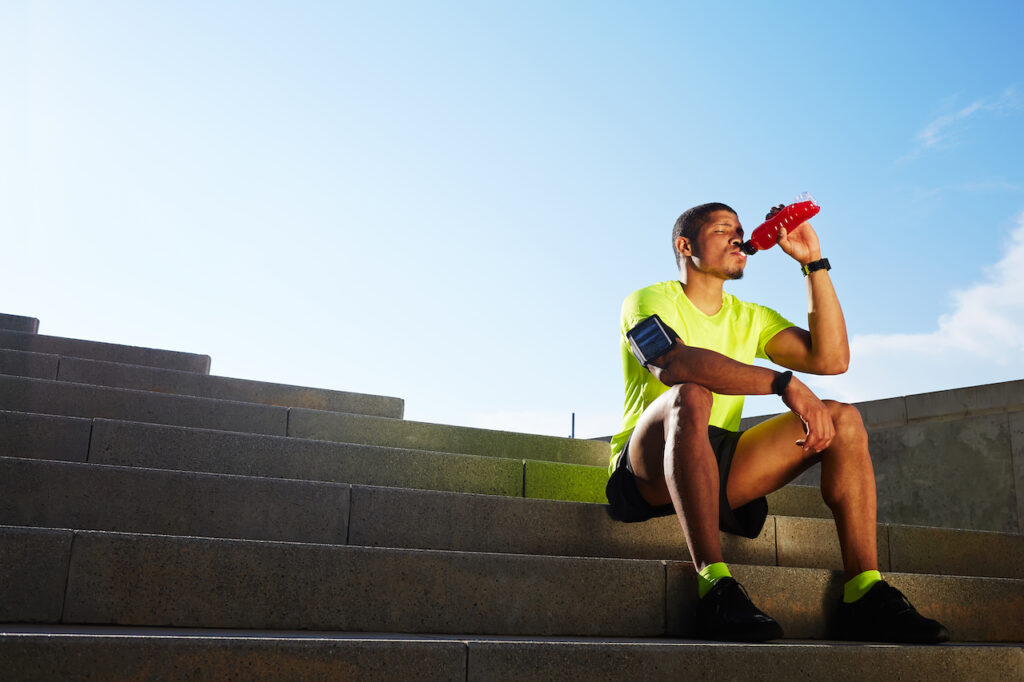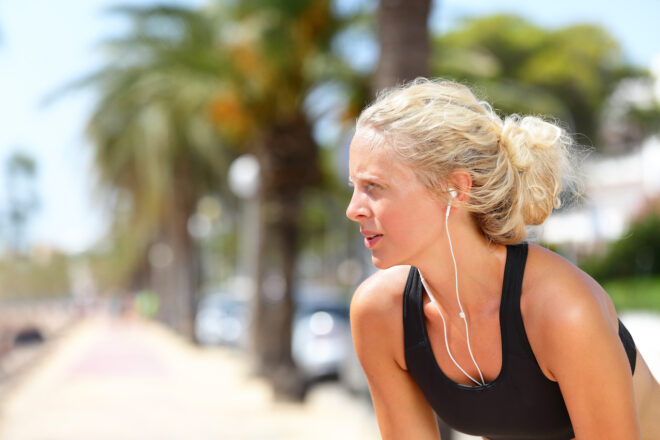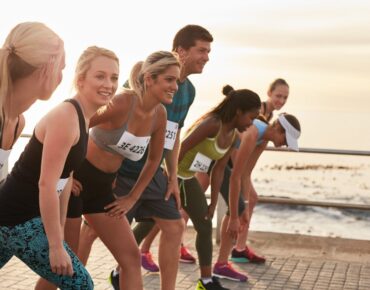Running in the heat may not be your idea of fun, but it’s doable and can be beneficial.
When you run at high temperatures, your body develops heat acclimation that can improve running performance. Running in the heat can make you a better runner.
Other benefits of running in the heat include building stamina and endurance and getting in more training during the summer. You can also burn more calories.
So maybe it’s time to embrace summer heat as a training tool if you haven’t already?
That said, running in the heat has its challenges and risks. Before you head out into the shimmering blaze of a summer afternoon, you want to be well prepared.
In This Article:
Why Is It Hard to Run in the Heat?
Heat affects your heart. Sweat contains plasma from your blood, and when you run in hot weather, you sweat more, which decreases your blood volume.
Because there’s less blood in your body, your heart has to work harder, resulting in a heart rather that’s 20+ beats faster.
Running in heat and humidity is a lot like training at altitude. It puts more physical stress on your body and requires more effort.
Does that mean you burn more calories running in hot weather?
Heat slightly increases your basal metabolic rate to keep your body cool. You burn more calories when you run in hot weather but at the same time, your body temperature increases, which makes you sweat more. Over time, your body learns to adjust to hotter temperatures.
Hot weather also affects recovery. Your body spends more energy cooling itself than delivering nutrients to your strained muscles.
Good to know: Running at temperatures over 85°F (30°C) noticeably strains your body and cardiovascular system. Ideal running temperatures are in the 45-to-59 °F (7–15° C) range.
What about fuel? Should you fuel differently when running in hot weather?
When you run in hot weather, your body uses more carbs than fat. You need to take in more carbs to make up for this.
How to Prevent Heat Related Illnesses and Ailments
Running in a temperature over 85°F (30°C) without taking precautions puts you at risk of suffering heat-related illnesses such as muscle cramps, severe dehydration, heat exhaustion, and heat stroke.
Headaches, nausea, dizziness, excessive sweating, and tiredness can be early warning signs. Read more about how to prevent heat related illnesses.
Heat Cramps
Heat cramps are muscle spasms you get when you sweat out fluid and electrolytes. They occur mostly in the legs and may be accompanied by mild fever under 102.5 °F.
You can experience them during or after a run. Heat cramps are not serious. Staying hydrated and taking a runners supplement rich in electrolytes can help you prevent them.
Severe Dehydration
Losing more than 4% of your body fluids while running can lead to severe dehydration. Symptoms include fatigue and dizziness, rapid breathing and heartbeat, and fainting.
Replace lost fluids and electrolytes by drinking water or a sports drink or gel. Even better, prevent severe dehydration by ensuring you’re hydrated before you start your run. You can tell this from the color of your urine—darker means not hydrated.
Heat Exhaustion
You’re more likely to suffer heat exhaustion if your body is not used to running in the heat. Symptoms include dehydration, nausea, headache, and a body temperature above 104 °F.
The best way to deal with heat exhaustion is to stop running and find cover under some shade. Drink cool water or a sports drink.
Heat Stroke
Heat stroke is a medical emergency. It occurs when the body becomes unable to cool down through sweating and reaches a temperature of 106 °F or higher. Symptoms include altered mental state, nausea and vomiting, racing heart, rapid breathing, headache, poor balance, and lack of sweating.
If during a run you experience some of these symptoms, stop and seek medical attention immediately.
To prevent heat stroke, use sunscreen, stay properly hydrated during your run, wear light clothing, and get some shade as soon as you notice signs of heat exhaustion (see above).
11 Great Tips to Run in the Heat
Eager for a summer run? Find out how to run in the heat without risking your health or allowing your performance to suffer.
Our tips for running in heat and humidity span all aspects of running including preparation, form, pace, time, outfit, and more. Let’s get practical!
Slow Down
Run by effort, not pace. This is a golden rule of running in the heat. Also, start slow and end slow.
Important: Keep an eye on the temperature both before and during your run. When the temperature reaches 60°F or higher, add 5-8 seconds per mile to your pace.
Once you get a feel of your running pace in hot weather, you’ll be able to adjust naturally. But until you get there, a bit of conscious thinking about how fast you run can help keep you safe.
Run Early
Head out early or late. Avoid the midday heat. During summer, the humidity may still be high in the morning, but you’ll avoid the blaze of the sun.
If you can’t run in the morning, run in the off hours or in the early hours of the night.
Seek Trails for Grass & Shade
Plan a shady route to get off the roads. You can get some much-needed shade this way while also avoiding the heat and pollution generated by cars.
Trail running is a wonderful way to connect with nature and it’s also easier on your feet since you won’t be running on pavements. Select the right routes by factoring in shade, noise levels, hydration options, safety, and distance from home.
If trail running isn’t an option, choose the next best thing and run on a treadmill. Make sure the exercise room is well ventilated and that the air conditioning is working properly.
Adjust Pace & Expectations
We’ve already seen that in the heat it’s better to run by pace rather than effort. To fine-tune your pace, you can adjust it according to the temperature and dew point.
Good to know: The dew point is a good measure of the effect of water saturation on your body.
During a long run, you could adjust your temperature according to whether the heat rises or falls.
Here’s how to adjust your running pace in the heat by increments:
1. Add the temperature plus dew point and adjust your pace based on the result. For example, a temperature of 60°F and a dew point of 50°F add up to a total value of 110.
2. Add the following decrease in pace as a percentage depending on your total as follows:
- 0.5% to your pace for 101-110.
- 1% for 111-120, 2% for 121-130, 3% for 131-140.
- 4.5% for 141-150.
- 6% for 151-160.
- 8% for 161-171.
- 10% for 171-180.
Wear a Light Outfit
Don’t wear dark colors. Leave cotton at home too because it absorbs heat without drying, trapping the heat close to your skin.
You can find running gear specially designed for running in the heat which wicks away sweat. Activewear is a good choice. Wear a hat or visor too.
Stay Hydrated
If you’re going for a long run, make sure to bring an electrolyte drink that replenishes what you’re losing. Also, consider taking a running supplement that provides electrolytes. Drink early and often and carry fluids on you.
Sports drinks or water? Which should you pick?
Water is good but sports drinks are often better because they pack electrolytes and possibly other beneficial nutrients. As we’ve seen, running in the heat predisposes your body to lose electrolytes faster than in average temperatures.

To stay properly hydrated, you want to calculate your sweat rate. Your sweat rate can be as high as 3-4 liters per hour, up to 10 liters per day. Running increases sweat rate by up to 20%.
Here’s how to measure sweat loss in the heat.
Things you’ll need: scales, stopwatch, measured (ml) water bottle.
- Measure your body weight before running in the heat.
- Measure how much fluid you drink during your run (in ml).
- Time your run.
- Hydrate during your run as normal.
- Record volume of fluid left at the end of the run.
- Remove wet clothing, dry yourself with a towel, and measure your body weight after exercise.
- Measure remaining fluid in the bottle if any.
- Calculate your weight deficit by transforming kgs in ml.
Example: 72 kg (before run) – 70.5 kg (after run) = 1.5 kg = 1500 ml. - Calculate body mass lost deficit with the formula: (weight deficit / 10) / weight before run
Example: (1500/10) / 72 = 2.08%. - Calculate fluid intake with the formula: pre fluids – post fluid
Example: 1250 ml – 350 ml = 900 ml. - Calculate sweat loss by adding fluid intake to deficit. Example: 1500 + 900 = 2400 ml (2.4 L).
- Calculate duration of run. Example: 45 minutes / 60 minutes = 0.75 hours.
- Finally, calculate sweat rate: 2400 / 0.75 hours = 3.2 L / hour.
Pour Water & Use Ice
Pouring water over your head in hot temperatures can help you get rid of heat and cool down a bit. The water shouldn’t be too cold or blood vessels in the face and scalp may constrict, further increasing your temperature.
Also important is to keep drinking water to stay hydrated—pouring water over you isn’t an alternative but an extra.
Once you finish your run, you can ice your muscles to reduce any swelling and pain and help them recover faster.
Be Patient and Take Breaks
Listen to your body as you run. Don’t be too ambitious. You can become a better runner and achieve more by being patient and taking breaks rather than pushing yourself to extremes.
Use Sunscreen
Another must is to protect your skin. You’ll probably be wearing shorts and light clothing that leaves your arms, legs, and neck exposed to the sun. Use an SPF 50+ sunscreen that doesn’t sweat off, dries quickly, and lasts for hours.
Run with Friends
Run with someone – or tell someone your plans for extra safety, especially if you’re going on a long trail run or exploring an unfamiliar area.
More than increasing safety, running with someone can be fun. You’ll have someone to apply sunscreen on your back too if you opt for a top over a t-shirt.
Refuel Minerals
Get salty minerals for the body to help it recover after your run. You can also snack on some of these when running. Sodium is one of the key electrolytes that get depleted when running.
Make sure to keep track of your salt intake though as sports gels and other runners supplements may include extra sodium.
Bananas, dried apricots, salted almonds, and whole grain products are ideal for replacing lost minerals and make great post-workout snacks.
How to Prevent Heat-Related Ailments
When you run in the heat, you may encounter some ailments that aren’t as serious as the heart-related illnesses we spoke about already.
But they can be unpleasant if left untreated, especially if you’re training for a marathon in the heat.
Here’s what you can do about them.
- Black toenails – Also known as runner’s toenails, this condition occurs when blood vessels under the nails break as a result of the repeated stress you put on your toenails. Keeping your toenails short, wearing runner’s shoes, and opting for cushioning socks can help prevent it.
- Blisters – The mix of heat, moisture, and friction make blisters common. To prevent them, rub baby powder or anti-chafing balm to your problem areas before running.
- Chafing – Minimize chafing during long runs in the heat by wearing clothing that allows your skin to dry. Consider also using a lubricating balm.
- Sunburn – We’ve spoken about sunscreen and the importance of using the right clothing. You can also wear clothing with built-in sun protection including bandanas and sunblock under your t-shirt.
- Sweaty Feet – Sweaty feet can lead to stinky shoes and may give you blisters. Use foot deodorant and wear quality running shoes and socks that let your feet breathe.
Take the Heat Off Running
If hot weather has been keeping you off the running trail, maybe it’s time to reimagine your summer runs.
But don’t try to beat the heat. That’s not what running in the heat is about. Rather, run with it. Listen to your body and slow down your pace to account for the temperature difference.
When you plan for it and take protective measures, running in the heat becomes an opportunity to challenge yourself and improve as a runner, without taking any risks.
Try it at least once. But don’t forget your hat and sunscreen!














